Propaganda
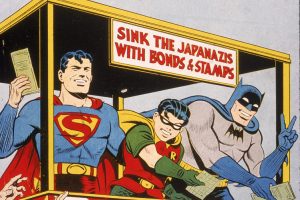
My digital exhibit is on wartime propaganda, its effect on the American people, and how its changed over time order to stay relevant. In a post-9/11 world where fear tactics have been on the upswing, it is more important than ever to understand the effect wartime propaganda has on us. The main lens of this project is through the eye of children. Every piece of media chosen is one that children would have interacted with. Children are the most impressionable of all, as they are constantly learning, meaning they are the easiest to persuade through propaganda and government-run information [1]. Children are also our future, and while it is still to be determined what the long-term effect propaganda from the War on Terror will have on my generation and the generations to follow, we can look to the past for a greater understanding of how other wartime propaganda has made its impact, and why it was so successful.
When people think about propaganda they think about icons like Uncle Sam and Rosie the Riveter; however, that is only a tiny fraction of wartime propaganda, and only in a narrow window of the 20th century. Propaganda changes the most drastically over the 20th century, because America and its wars changed the most drastically over the 20th century. America began the century as an isolated nation, and one that had not fought a large-scale war since the Civil War. It had a long-standing tradition of isolationist ideology separating from the rest of Europe and the world, and when Archduke Franz Ferdinand II was shot in 1914, this isolationist, inexperienced, economically vibrant nation’s government wanted nothing to do with it [2][3]. By the end of the 20th century America has become the policer of nations, the mediator of every conflict, regardless of the consequences. America changed from an introverted stance to an extroverted stance. It was no longer willing to sit idly; instead it actively tried to police the rest of the world. In certain cases, even acting proactively when it felt it needed to.
Wartime propaganda drives patriotism and nationalism which also frequently extends long after peace treaties are drawn up. A great example is World War II propaganda which effectively combatted dwindling American isolationists, and did so well enough that it was a factor in shifting American foreign policy away from isolationism permanently. Frequently wartime propaganda comes down to two techniques: fear tactics and inspiration. Fear tactics usually boil down to exploitation of pre-existing xenophobia and racism; whereas, inspiration usually serves to create a “patriotic” ideal that can defeat any enemy, and overcome any obstacle in its way; in other words a “superman”. Down to a basic level, propaganda is information put out by a government to encourage its people to think in a certain way. It pushes an agenda and encourages a particular ideology. An analogy would be a shepherd and his sheep. The government is herding the people through complicated ideas within the realm of foreign policy like war through over-simplification and frequently distortion of reality to create a rallying point. It creates a false unity in the hopes it will last long enough to win the war or to push policy change, or maintain the power structure of a nation. Propaganda is inseparable to the idea of a nation, as it needs a physical rallying point as much as it needs a psychological one. Successful propaganda creates a “us” vs “them” mentality, yet cannot do so without a nation. In some cases it can even “create a nation” by rallying enough people around a set of ideas.
As referenced earlier, every piece of media in this exhibit is tailored to the experience of a child growing up during these wars. World War I propaganda was driven by radio and posters, many of these posters would be hung up publicly to encourage able-bodied men to enlist. Some Children would enlist as well, others would learn about the world and other countries through posters like these and by World War II in nearly everything they encountered [4]. Even classic cartoons like Popeye the Sailor, Looney Tunes, and Donald Duck all addressed World War II. The propaganda ran rampant during World War II, as even comic icons like Superman and Batman began selling War Bonds, forcing children to learn about the harsh reality of war, and did so through these iconic characters and the way they interacted with nazism, Hitler, and the army. Starting as early as 1946 in some cases, American propaganda shifted away from nazis and towards communists, and unlike before, many classes presented films like Red Nightmare. Short films like “Red Nightmare” fall into the modern category “scare tactics”, because instead of telling a story or portraying two sides to an argument it focuses solely on instilling fear into the audience.
Each and every generation interacts with information media (television, radio, newspapers, posters, comics, cartoons, etc.); however, we frequently underestimate the power of this media, as it has the ability to shape the mindset of the next generation. Wartime propaganda made its way through all kinds of information media, and its influence on the children who grew up during these wars was observable through trends like volunteering for the draft even before they were allowed to.
Footnotes: [1] Wright, Katherine [2] Foner, Eric [3]Cook [4] According to Richard van Emden, author of Boy Soldiers of the Great War, Sidney Lewis was the youngest soldier enlisted to the British Navy at age 12.
World War I
“Step Into Your Place”
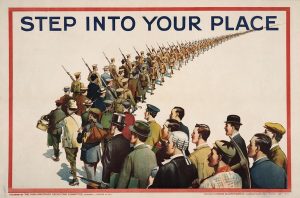
World War I Recruitment Poster
This poster would have been seen publicly displayed during World War I. This particular photo was originally British, but widespread. This photo encouraged in this instance the British to enlist into the war effort, and one of its main targets are people who believe they are exempt from the war. This can be seen through the men in the foreground who are all wearing different clothes, whether the judge, businessmen, miners, or poorer men, they are all there to serve their country. This plays into the theme of World War I propaganda which was very individualistic in nature, as it tried to fight against strong isolationist tendencies. Many posters like this one target individuals rather than calling upon a collective fighting spirit.
“Enlist: On Which Side of the Window are You?”
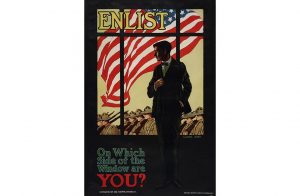
World War I Recruitment Poster
This is an American recruitment poster looking very similar to the British one up above, as it highlights the individual and pressures them into joining the war effort. He is seen up against a window, which itself is a metaphor for isolationism. He in this case is physically isolating himself from the army, the flag (which represents his country), and even daylight. He is looking over his shoulder, questioning his decision.

Buy A Liberty Bond
This poster highlights the power the individual had to help out the army by buying bonds if they still refused to enlist. It shows this figure who somewhat resembles Captain America as a representation of the US army with the power of “liberty loans”. This manifestation of American might is rising from the smoke and fighting figures dressed in black, very much like an old comic book.
World War II
War Bonds Poster: “Don’t Let that Shadow Touch them, Buy War Bonds”

This poster was produced by the US government in 1942, shortly after American troops engaged in combat. The intended audience was wealthier Americans whom the government wanted to buy bonds so as to increase funding for the war effort. It was likely also aimed at parents as it focuses on the three unhappy children surrounded by aspects of war like the plane the one child is holding. Another eye-catching aspect is the large shadow of a swastika on the ground which encompasses the foreground in a foreboding atmosphere. This plays more into the fear aspect of the propaganda which was rather unusual for American propaganda which was usually more patriotic and hopeful. I found this in World War II propaganda: Analyzing the Art of Persuasion During Wartime.
1942 War Bonds Poster produced by the US Government
Action Comics “Superman Says, ‘You Can Slap a Jap…With War Bonds and Stamps” Action Comics
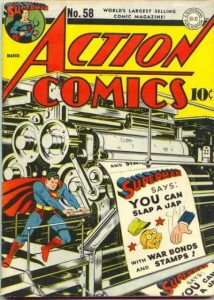
Action Comics #58 “You Can Slap a Jap With War Bonds and Stamps”
DC comics was no exception to piling onto the war effort with their patriotic, red-white-and blue clad hero Superman. Throughout the war there were comics that begged those wealthy enough to collect comics like Action Comics to invest back into the US government. This particular comic stands out because it is blatantly pro-war and jarringly racist. The intent is to rouse American war spirit and to raise funding. This ties into just how far and wide the propaganda seeped into American pop culture. If characters such as Superman were part of the war effort, then ever child reading that comic wanted to help too, after all who did not want to be like Superman? This comic was not that rare as both Superman and Batman promoted War Bonds on their comic covers throughout the war, and Captain America was created for the same reasons. His first appearance involved him punching Hitler in the face.
Bugs Bunny. “Herr Meets Hare.”

Bugs Bunny Posing as Josef Stalin
https://dai.ly/x2mvoxo (full video)
This cartoon aired in 1945 and went under the name “Merry Melodies”, and was owned by Warner Brothers. The intended audience was children, and its intention was to mock the nazis and their cause and encourage children to support America. It takes the bumbling sergeant Schultz cliche and applies that to the German people, as well as showing Bugs Bunny outsmarting Hitler. It downplays the Nazis and tells children that even they can outsmart the Nazis. This is one of the many cartoons that children would have watched whom likely would not understand why the war was happening, nor what the stakes were. This cartoon would have introduced the war to children, and attempt to explain it to them in a way they would understand who was right, who was wrong, and that America was the greatest. On a final note, one of my favorite parts was at the end where Bugs Bunny scares Hitler by dressing up as Stalin which is a funny nod to how badly the Nazis were losing to the Russians on the eastern front.
Donald Duck. “Der Fuhrer’s Face”
“Der Fuhrer’s Face” was released in 1943 and was produced as war propaganda by Disney. Its goal was to encourage children to be patriotic and bash nazism through somewhat racist and unflattering depictions. It sets up a contrast between what the US government wanted children to believe nazism looked like and what Americanism looked like. It is significant to my research as it was geared towards children who are historically more susceptive to this kind of propaganda as they will be less likely to question than adults. Disney did not release this short on home video of any kind until 2005.

Superman witnessing the Bikini Atoll Nuclear Test
Cold War
Romm, Mikhail. Ordinary Fascism/Triumph Over Violence/Echo of the Jackboot
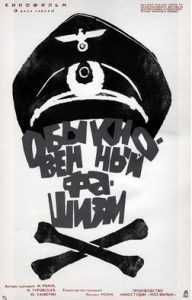
Theatrical Poster from Mikhail Romm’s “Ordinary Facism”
This Russian film was produced during the Cold War but it commentated on both World War II and the Cold War, hence its inclusion as a primary source. It was funded by the Soviet Government, and was made in 1968 after the “thaw” ended and US and Russian relations escalated again. Its goal was to convince the Russians that the Soviet way of life was the only way of life. Its audience was a large Russian audience which saw its release at the 1968 Film Festival. The mockumentary was comprised entirely of archival World War II footage with narration from Romm throughout the film. This source provides a more well-rounded notion of how not all propaganda was the same, particularly in different countries. At different points in the film there are morbid photos of the concentration camps, and the millions who died there. These are not designed to scare the audience, but instead to stir up a patriotic fervor to combat the fear of a “New Hitler” or a “New Nazism” that Romm expresses great concern over towards the end of the production. However, to truly grasp where this fear, patriotism, and demonization comes from, one must understand not just the events of the war, but the propaganda as well.
Kubrick, Stanley. Dr. Strangelove or How I Learned to Stop Worrying and Love the Bomb

Dr. Strangelove Movie Poster (1964)
Stanley Kubrick’s 1964 cult classic Dr. Strangelove is the most unique of the propaganda I have encountered because it is also a satire. The audience was for adults who had been living through the Cold War as well as the American government whom were presented as war-mongering and overtly nationalistic. It is another example of Cold War propaganda because it bashes a lot of the existing propaganda, and could not do so without introducing what the propaganda is. This is a movie I personally enjoy, and felt that it integrated well with my topic. Interestingly enough, there was a large outcry from the military who felt like they were portrayed as bumbling and ignorant (i.e. scene where American shouts yee-ha and waves his cowboy hat while riding a nuclear bomb).
Red Nightmare 1957 Department of Defense.
Red Nightmare is a completely different kind of Cold War propaganda than Strangelove, because it was a Defense department film that created a terrifying image of communism to uneducated Americans. It was made in 1957 but not widely released until 1962. Its intent was to raise anti-communist fervor as well as the defense budget if they presented a sizable threat to the American people. It focused on the lack of freedom in “Communistville” compare to the “American town” as well as inverted gender roles and elimination of trial by jury and other aspects of habeas corpus. This movie is fascinating because it shows the major concerns of American people based on what the Defense department thought would be the scariest and most un-American things they could incorporate to “Communistville”. I found this source in archive.org, but it played much better on YouTube.
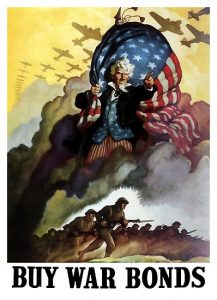
Bibliography: “Popular Culture, Art Education, and the Committee on Public Information During World War I, 1915-1919.” Visual Arts Research 37, no. 72 (Summer 2011): 67–78. Bernhard, Nancy. US Television News and Cold War Propaganda, 1947-1960. (Cambridge, 1999.) Cook, Jia-Rui. "The Posters That Sold World War I to the American Public", Smithsonian Magazine. (Smithsonian July 2014) Foner, Eric. Give me Liberty! (W. W. Norton & Company; Seagull Fifth edition: 2017) Fyne, Robert. Hollywood Propaganda, (London, 1994) Laurie, Clayton D. The Propaganda Warriors: America’s Crusade against Nazi Germany. Modern War Studies. University Press of Kansas, 1996. Soules, Marshall. "Propaganda and Global Economics." In Media, Persuasion and Propaganda, 173-97. Edinburgh: Edinburgh University Press, 2015. Toler, Pamela D. “Propaganda with a Passion.” MHQ: Quarterly Journal of Military History 30, no. 4 (Summer 2018): 88–90. Welch, David, World War II Propaganda: Analyzing the Art of Persuasion During Wartime, (ABC-CLIO 2017). Winkler, Allan, The Politics of Propaganda. (Yale, 1978). Wright, Katherine. “THE READY ONES: AMERICAN CHILDREN, WORLD WAR II, AND PROPAGANDA” (Miami University, 2015). https://etd.ohiolink.edu/!etd.send_file?accession=miami1430779836&disposition=inline
Primary Sources (In order of Appearance): "Step Into Your Place" World War I Recruitment photo. (1915). Reprinted in “World War 1:100 Years Later” Smithsonian Magazine (2014) "Enlist: On Which Side of the Window are You?" World War I Recruitment Photo. (1917). Reprinted in “World War 1:100 Years Later” Smithsonian Magazine (2014) "If You Can't Enlist-Invest: Buy a Liberty Bond: Defend Your Country With Your Dollars" (1918). Reprinted in “World War 1:100 Years Later” Smithsonian Magazine (2014) War Bonds Poster: “Don’t Let that Shadow Touch them, Buy War Bonds” (USA, 1942) Action Comics “Superman Says, ‘You Can Slap a Jap…With War Bonds and Stamps” Action Comics, vol 1 issue #58, DC comics, (March 1943). Warner Brothers. “Herr Meets Hare." Merry Melodies. Burbank, California 1945. Walt Disney Studios. “Der Fuhrer’s Face” Disney, Burbank, California 1943. Romm, Mikhail. Ordinary Fascism. [Russia] Armenfilm, 1968. Kubrick, Stanley. Dr. Strangelove or How I Learned to Stop Worrying and Love the Bomb, [United Kingdom] Hawks Films, 1964. Waggner, George. Red Nightmare [Washington D.C] 1957 Department of Defense.

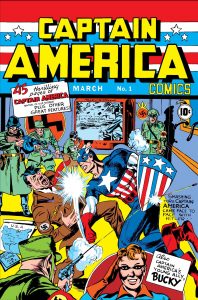
So to tell the truth I do not know how to set up a folder and separate it so I did it this way and just included some bonus photos…enjoy 🙂